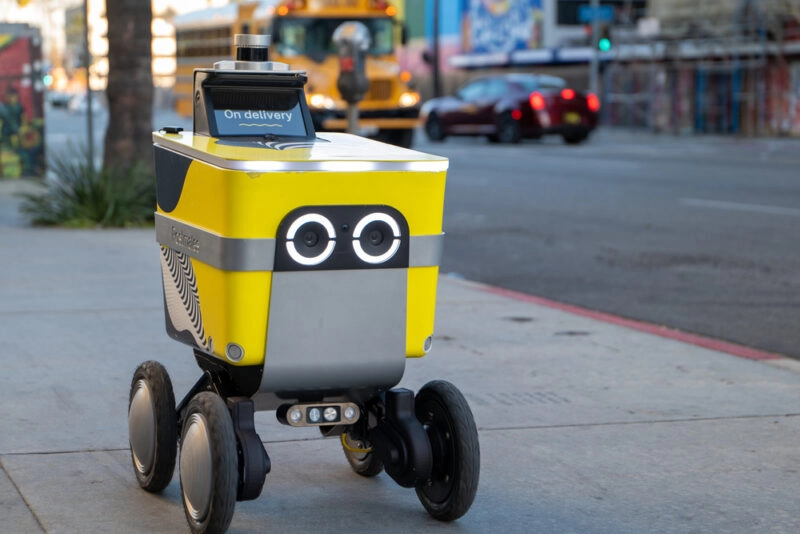Are Uber & Lyft On the Road to Profit After Q2’s Earnings?
Earnings season is always a mixed bag, and Q2’s reports were no exception. Almost 50% of telecom companies missed their targets for the quarter, while companies like Home Depot, Salesforce and Spotify reported surprising over-performance. For leading rideshare companies, though, early August’s earnings were record-breaking and reframed a long-running narrative of persistently negative cash flow. Does this mean the road towards profitability is finally in sight for the rideshare giants?
Both Uber and Lyft reported positive EBITDA in Q2 2022. This may seem like an optimistic yet uneventful update, but it’s a significant reversal for both companies when comparing adjusted and unadjusted earnings. Uber clocked in $364 million in unadjusted cash flow before factoring in interest, tax, depreciation, and amortization. This rose the company’s earnings by $873 million year-over-year. In terms of “free cash flow,” or adjusted income that reflects more readily-available cash-on-hand, the company recorded $382 million, up $780 million YoY. This makes Q2 2022 the first quarter of positive free cash flow for the company ever. Revenue grew considerably, reaching $8.1 billion and up 105% YoY. Its mobility gross bookings alone drew in $13.4 billion, up 55% YoY, with 1.87 billion customer rides. Lyft posted $79.1 million of adjusted cash flow, which represented a 232% year over year increase in earnings. Overall, Lyft’s quarterly revenue reached $990.7 million, exceeding the company’s outlook.
Historically known for being one of the most highly-ranked and highly invested-in tech disruptors that also can’t seem to turn a profit, this news doesn’t put Uber in the green just yet; the company again reported a net quarterly loss, this time of $2.6 billion. This loss includes expenses related to stock-based compensation, and revaluation of the company’s stakes in Aurora, Grab and Zomato. Lyft was in a similar position, reporting a Q2 net loss of $377.2 million.
Considering Uber has spent over a decade operating in the red, any sign of positive cash flow is a bullish signal for Wall Street analysts. Shares suggested as much as Uber’s stock value jumped 14% in early trading after the company released its report. Despite the billions in operating loss, investors did not appear concerned; the loss was billions less than Q1’s, and it’s fair to say that positive cash flow is positive. The burning question, then, is whether this is a growing trend of profitability for the gig economy or an outlier for a still unsustainable business model.
Sergio Avedian, a senior contributor for The Rideshare Guy and a consultant for various Wall Street firms on the gig economy, said the Q2 news reports from Uber and Lyft weren’t surprising.
“Everything I expected happened. I call it the perfect storm. It’s a perfect storm in a good way for Uber and Lyft,” Avedian said. “For rideshare companies, but also for the gig economy companies such as DoorDash and Instacart, which is about to go public by the end of the year.”
Uber’s Shifting Profit Strategy
Honing in on just Uber, the factors that led to its quarterly successes aren’t “rocket science,” Avedian explained. Through a mix of targeting driver expenses and refining its algorithm, a record quarter of positive cash flow was a natural consequence.
“[Uber was] able to lower their costs and were able to charge more,” Avedian said. Considering Uber operates a low asset business model where it owns neither the vehicles nor the maintenance responsibility, its largest cost comes from its variable inputs: drivers.
“What Uber has to do, through its algorithms, is it has to manage to charge more to the passenger and pay less to the driver, and that’s exactly what happened the last quarter, the last three months,” Avedian said.
After reporting Q1 2022 earnings, Uber CEO Dara Khosrowshahi made it clear that the company was retooling its profitability strategy moving forward in a company-wide letter. The company operated for over a decade seeking a goal of $5 billion in EBITDA by 2024. While Uber made progress on this goal, it is still nowhere close to billions in pre-expense earnings. This was clear enough by Q1, and it prompted Uber leadership to announce that “the goalposts have changed.”
“Now it’s about free cash flow. We can (and should) get there fast,” Khosrowshahi said.
More Riders, More Drivers, Better Margins
To effectively shift profitability metrics, especially in the watchful eyes of investors, this included rolling back the “least efficient marketing and incentive spend.” Any “initiatives that require substantial capital” became the first area to decisively improve margins and fulfill a renewed promise of cash flow positivity to investors. It appears that this included driver incentives and bonuses, which have remained stagnant for months even as high gas prices persist. Anecdotal reporting from major outlets like NPR and community outlets like The Rideshare Guy highlights diminishing returns on the incentives that do remain.
Avedian has been conducting deep-dive analysis of driver pay-outs for years, using his own returns and those of the Rideshare Guy community as data. His most recent look into rideshare driver earnings found that, anecdotally between him and other surveyed drivers, July had some of the worst returns for drivers in recent memory. This was confirmed by Uber’s CEO, Dara Khosrowshahi, during an interview with The Rideshare Guy’s Harry Campbell: since Khosrowshahi’s appearance at the Bloomberg Technology Summit in June, driver earnings have dropped nearly 25%. A combination of an oversaturated market of drivers, discrepancies between Uber’s estimated and actual “utilized hour” driver earnings, and fluctuating rider demand amid a quarter of high inflation are leading to low earnings compared to last year. All of these factors combined to create Avedian’s “perfect storm” scenario for Uber’s positive cash flow.
“They have all the drivers out there that they need. Due to inflation, many drivers are driving again to supplement their W2 jobs. And what easier way to enter the gig economy than Uber and Lyft,” Avedian said.
Uber reported a 31 percent increase in drivers year-over-year. With no driver shortage, and therefore adequate (if not excessive) labor supply to run the ship, Uber can more easily control its operating expenses.
Q2 earnings showed not just a boost in YoY drivers, but ridership as well. Even with historical inflation, consumers are still spending on rides and travel conveniences as Uber reported consumer bookings were up 33% YoY, while Lyft added two million Active Riders over Q1’s numbers. Comparing trip volume between Q2 2019 and Q2 2022 shows that booking numbers have recovered beyond pre-pandemic levels, from 1.68 billion trips to 1.87 billion trips respectively. Still, even with this positive metric, the pandemic’s rebound of ridership isn’t something Avedian is counting on as a sustainable route for permanently bringing Uber into the green.
“It’s still a growth company if you want to call it that, but the growth is going to slow down…to single digit margins this year and then flat next year. But now, they have to figure out how to squeeze profit out of 122 million users that they have in the U.S.,” Avedian said.
If the slowdown prediction holds, Uber and Lyft need to create new strategies to increase profitability amongst users, especially if the long-looming recession comes to full fruition.
“At some point, if we do go into recession, the consumer will start tightening their belts,” Avedian said. “The slowdown in the economy actually helped [Uber] with the driver supply, but it might be a headwind going forward.”
Uber was also finally able to achieve positive cash flow this quarter through a slow-but-steady increase in consumer-facing prices, padding its margins to maximize returns on a growing ridership base.
“From 2019, pre-pandemic levels, pretty much every single trip is up 50 to 100%. Uber is able to charge 50 to 100% more for the same 10 mile trip that you used to pay $10 for. Now the same trip is $20. At some point, this may become a luxury. A lot of people actually left public transportation and then took Ubers and Lyfts when it was the VC-backed subsidized fantasy land for the passenger, but those things are changing now,” Avedian said.
Analysis from the last year or so reflects the same trend Avedian has himself faced as an Uber rider:
- CNBC reported data from Rakuten Intelligence showing average rideshare rides increased by 92% from January 2018 to July 2021.
- NPR’s reporting pulled data from GridWise reflecting a similar wholesale boost in prices: an average fare increase of 79% from pre-pandemic levels.
- MarketWatch found that Uber & Lyft prices are getting so high, that riders are turning back to taxi services.
- Uber CEO Dara Khosrowshahi admitted in a Twitter thread last summer that Uber fares increased around 27% between the period of January and May 2021.
- The New York Post reports anecdotal accounts of Uber trips in the Lower East Side costing 150% more than in 2017.
Another important factor from the last quarter that influenced the company’s cashflow is Uber’s pricing model algorithm, which recently went through a complete remodel to better calculate driver pay and rider fares in order to min-max returns. In an effort to attract new drivers and promote transparency, Uber’s new algorithm and UI now calculates and displays how much drivers will make on each trip and where they’re headed before they ever accept a ride. An important consequence of this change is that rider fares and driver pay become decoupled. Whereas before rider fares were calculated by solely fixed time and distance rates, new “upfront fares” factor in things like real-time demand, destination-related metrics, and other still-unrevealed and unreported metrics proprietary to the algorithm.
“Uber finally has figured out how to completely separate what the passenger pays from what the driver receives,” Avedian said. “I think Uber now can comfortably be profitable on every single ride, as opposed to losing money on one, make money on two. The systems that they’re running now are brilliant. So, going forward, they don’t need to chase growth any longer; they just need to optimize their systems and machine learning systems to squeeze additional profit on each trip.”
Can Rideshare Giants Keep Up the Profitable Pace?
The positivity around Uber’s cash flow is a testament to CEO Dara Khosrowshahi’s pledge earlier this year for the company to get serious about cost controls. In his Q1 letter to the company, Khosrowshahi challenged the team to beat profitability commitments on both EBITDA and free cash flow metrics, and the company’s cost-cutting strategies delivered. With this possible new formula for creating positive cash flow, the company now has more tools for convincing investors that the company is still on a path of operational and revenue-driving maturity. Khosrowshahi’s plan of showing not telling a growth narrative is paying off.
“Channeling Jerry Maguire, we need to show them the money,” he wrote. “They see how big the [total addressable market] is, they just don’t understand how that translates into significant profits and free cash flow. We have to show them.”
Avedian believes positive comps will be harder for Uber and Lyft in Q3. The Q2 news for both Uber and Lyft showed promise, but those YoY comps were like comparing apples to oranges with COVID’s lockdowns and travel demand destruction taken into context. And though Avedian agrees that Uber is on the “right path” on the road toward profitability, this is likely still a one-quarter blip; Wall Street analysts and investors know that one quarter doesn’t make a trend. Especially considering the unique nature of Uber’s YoY metrics, which reflect growth off of pandemic-era numbers, it’s hard to expect ridership growth and the margins that come from subsequent price increases to hold to the same degree.
“To be perfectly honest, the 33% increase came on the back of a quarter where rideshare was not back to normal yet. The country was not open,” Avedian said.
Current factors like recent CPI numbers reflecting inflation stagnation, consumers already feeling shackled by the economic climate, and the continued monetary policy efforts to cool consumer demand through interest rate hikes may put the brakes on building a profitability trend. Even if Uber and Lyft play all their cards right, macroeconomic instability and its effect on perceived consumer conveniences will be the true test of Uber’s cash flow resiliency.
“At the moment, demand is exactly matching, if not surpassing, pre-pandemic levels. What Uber, Lyft, and other gig economy companies need to do is watch how the shifting economy affects demand, and react accordingly,” he said.
Article co-written by James Kent and Daniel Litwin.
Recent Posts

The rise of autonomous delivery robots is shaping the way urbanites receive their meals in the world of food delivery. Serve Robotics, an Uber spinout, is amplifying its collaboration with Uber Eats by deploying up to 2,000 autonomous sidewalk delivery robots across several U.S. markets through 2026. Initiated in West Hollywood, Serve’s robot deliveries…





